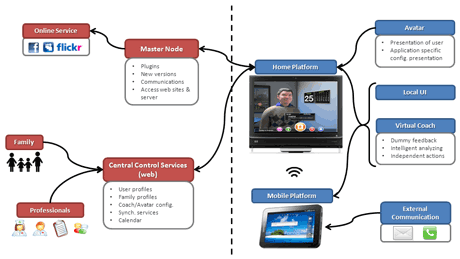by Daniel Tantinger and Andreas Braun
The V2me project combines real life and virtual social network elements to prevent and overcome loneliness in Europe’s aging population. Its overall goal is to enhance the joy of living for the network members. To fulfil this goal, V2me supports active ageing by improving integration into society through the provision of advanced social connectedness and social network services and activities.
Rooted in scientific theory and research, V2me uses evidence-based prevention and intervention strategies to develop a social facilitator that enables both prevention of loneliness in young-old individuals (65-74 years) and successful intervention in older generations (75+ years). V2me encourages older people to continue their social participation, to share their knowledge and experiences and to stay mobile and cognitively agile. Development of an adaptive and easily expandable ICT solution for assistive living with particular emphasis on acceptance by senior end users that addresses the social interaction of people and contributes to preventing and alleviating loneliness was the initial motive, and still is the main goal, for the V2me project. This European AAL Joint Programme project started in May 2010 and will run for 36 months.
Specifically, V2me stimulates beneficial levels of social activity in elderly individuals who are at risk of isolation. Furthermore, it supports behavioural changes in patients who consider themselves lonely or isolated. The system is integrated into existing online social networks and amends them with innovative services that improve usability for elderly users.

Figure 1: Schematic concept of the V2me project.
The fact that adaptive ambient solutions include the whole gamut of high end software and devices in conjunction with psychological intervention methods leads to a hybrid program between technological and psychological state-of-the-art knowledge. The project combines the application of state-of-the-art social sciences (social gerontology, psychology, and communication) and state-of-the-art technology in a real-life environment that allows user participation in all phases of the project. Furthermore, it combines approaches from various scientific fields to prevent loneliness especially for elderly people.
Specifically, V2me provides senior individuals suffering from or being at risk of loneliness with an adaptive ICT environment that implements a multi-facetted approach to motivate the user to engage in different forms of social activity. This includes a mediator function to stimulate the use of ICT technology for developing network relationships. This aspect facilitates contact with family, friends, and professional networks, as well as potential new communication partners (enriching social networks). The second cornerstone is the friendship function, compensating the absence of social connectedness through offering coaching in deepening relationships. The system interacts with the user in an adaptive, personalized way to establish a para-social relationship as an additional contribution to preventing loneliness. Both aspects are incorporated in the V2me Virtual Coach, an emotionally expressive virtual character that is companion, instructor or even a mate. It is based on previous work accomplished in the AAL JP Call 1 project - A2E2. Our approach does not only rely on intrinsic motivation or knowledge about successful intervention, but stimulates user motivation and positive reinforcement. To achieve the latter, we use state-of-the art technology to tailor the V2me User Avatar. This virtual self-representation of the user is a dynamic virtual entity that is directly or indirectly controlled by the end-user, offering various abstraction levels of representation that are controllable and individually configurable by the user, giving the user full control of his appearance to the system or other users.
The V2me system consists of three main components - the Mobile Platform, a location-aware tablet-based solution that allows the user to connect with his social network and interact intuitively with the Virtual Coach. This emotionally expressive 3D character is residing on the Home Platform, a large screen device that is placed in the user’s immediate environment and uses naturally sounding speech synthesis for communication. Both devices are connected to the Web Platform that connects the different users and integrates third-party services. The first prototypes have been tested and we will continue with further user studies in three different countries - Finland, Germany and the Netherlands. This will include a long-term study on the effectiveness of our approach on loneliness prevention.
The core consortium is formed by a strong group of organizations from six member states with long-standing experience of working together in different European and international projects and a deep knowledge and expertise in the different domains of Ambient Assisted Living, e Health and e Inclusion. The consortium is composed of nine partners - small and medium enterprises, health care providers, research and development organizations and social science research institutions that mutually share the V2me vision. Those partners are: Fraunhofer Gesellschaft, Germany (project coordination); Diakonie Neuendettelsau, Germany; Hospital IT AS, Norway; Mawell Ltd., Finland; Graz University of Technology, Austria; User Interface Design GmbH, Germany Université du Luxembourg; VU University Amsterdam, Netherlands; VTT Technical Research Centre of Finland.
Link: http://www.v2me.org
Please contact:
Daniel Tantinger
Fraunhofer Institute for Integrated Circuits IIS, Germany
Tel: +49 9131 776-7343
E-Mail:
Andreas Braun
Fraunhofer Institute for Computer Graphics Research IGD, Germany
Tel: +49 6151 155-208
E-Mail:










